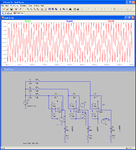Johnny101
Member level 1
Hi guys,
I have made a few general observations related to the usage of single supply and dual supply op-amps and wanted to know if I am moving in the right direction. Please correct me where wrong.
- If input signal is positive and has no -ve part then single and dual supply op amps are analogous?
- If signal is single ended (having both -ve and +ve part) and we have a single supply op amp - just bias the op amp at half the supply?
- If signal is differential (having both -ve and +ve part) and we have a single supply op amp what do we do now?
Could we add an offset to the input signal before giving it into the op-amp?
- If we have a dual supply op-amp it doesn't matter what type the input is?
Thanks in advance.
I have made a few general observations related to the usage of single supply and dual supply op-amps and wanted to know if I am moving in the right direction. Please correct me where wrong.
- If input signal is positive and has no -ve part then single and dual supply op amps are analogous?
- If signal is single ended (having both -ve and +ve part) and we have a single supply op amp - just bias the op amp at half the supply?
- If signal is differential (having both -ve and +ve part) and we have a single supply op amp what do we do now?
Could we add an offset to the input signal before giving it into the op-amp?
- If we have a dual supply op-amp it doesn't matter what type the input is?
Thanks in advance.


